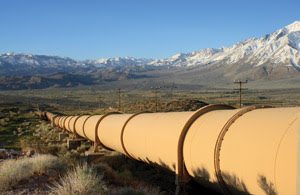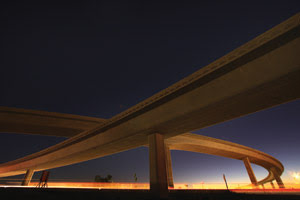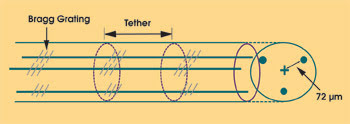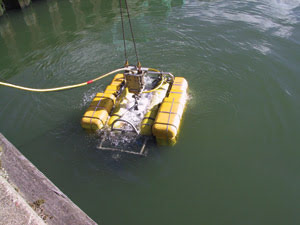A new twist on an old technology clears the way for new applications.
Dr. Brian J. Soller and Trevor Rice, Luna Innovations Inc.
Optical fibers make ideal physical sensors. Light, rugged and immune to interference from stray electrical signals, they respond to a variety of external stimuli – qualities that have spawned extensive efforts to use them for measuring, or “sensing,” physical attributes such as temperature, strain and pressure. They are used for temperature monitoring in oil and gas “down hole” and applications, strain and fatigue monitoring in civil structures (dams, bridges) and buildings, strain measurement in composite structures and intrusion monitoring in security applications.

Fiber sensors monitor pipeline temperature.
Advances in sensor and readout architectures have led to the introduction of systems that measure, in three dimensions and in real-time, the shape of a length of optical fiber.
This capability brings with it a host of potential applications in what is currently a $1.6 billion global market for position and location sensing solutions.1 Among the most intriguing is the use of optical fiber to monitor the position and location of medical instruments (surgical tools, catheters, scopes) inside the body during minimally invasive surgery (MIS). In contrast to open surgery, where the organ or tissue is exposed through large incisions in the body, MIS procedures generally involve faster recovery time, less pain and trauma, reduced risk of infection and shorter hospital stays.

Many of the world’s largest and fastest-growing companies offer high-tech endoscopes, catheters and even surgeon-guided robots to perform these complex procedures. The Mayo Clinic says it offers more than 100 MIS procedures at its hospitals in Scottsdale/Phoenix, Ariz., Jacksonville, Fla., and Rochester, Minn. The surgeries are divided into 10 categories: heart, colon and rectal, gastroenterologic, gynecologic, orthopedic, otorhinolaryngology, thoracic, urology, vascular and neurosurgery. In the US alone, more than 2 million MIS procedures are performed annually. With the trend toward smaller and more flexible devices, shape-sensing fiber will help enable new MIS procedures and will improve the performance of existing ones.
Natural Orifice Transluminal Endoscopic Surgery™ (NOTES™) is a new subset of MIS procedures being studied at research hospitals and facilities worldwide and is a particularly promising emerging market for shape-sensing technology. The idea of NOTES was developed several years ago in recognition of the fact that patients would benefit from reduced recovery time following less invasive surgery, would experience less physical discomfort than with traditional procedures and would have virtually no visible scarring. One example is a procedure to remove the gallbladder using long flexible surgical tools and cameras inserted through the mouth, down the esophagus and through the stomach wall. These advances have encouraged physicians and researchers to develop new equipment and techniques to use during NOTES procedures.
Inspiration from NASA
Using technology inspired by NASA, Luna Innovations Inc. has developed a fiber optic shape and position sensor. The fiber optic cable is virtually weightless and can provide real-time feedback regarding its own dynamic shape and position. When embedded in or surface-attached to surgical tools or other devices, the fiber can monitor the dynamic 3-D shape of the tool, independent of the temperature or load environment. This is made possible by tens of thousands of optical sensors called fiber Bragg gratings (FBGs) embedded in the fiber that can be read with very high spatial resolution.
The readout technique that delivers the shape of the fiber is called optical frequency domain reflectometry (OFDR). OFDR employs a continuously tunable laser that simultaneously interrogates the spectrum of a multitude of fiber Bragg grating sensors along a fiber and enables detection from hundreds to thousands of FBG sensors embedded along the length of the fiber.
For shape measurements, the fiber consists of high density arrays of FBG strain sensors in multiple fiber cores aligned in the axial dimension and packaged as a monolithic structure in a particular geometry. Advanced algorithms use the strain differential as seen by the fiber optic sensors to calculate the bends at every discrete element along the length. Because of the sensor density, each individual sensing element can be integrated to reconstruct the total shape of the fiber.

Figure 1. A multifiber sensing element with three axially arranged cores.
Figure 1 shows a fiber with three cores arranged axially in an equilateral triangle within the fiber cladding. The strain is measured by FBGs that are written into the cores using a high-power pulsed excimer laser at a constant axial spacing. The FBGs consist of a periodic change in refractive index that reflects a very narrow band of light, the exact wavelength of which is dependent on the period of the refractive index variation. When the fiber is under strain, the period is slightly perturbed, changing the wavelength of the light that is reflected back to the interrogator. It is through this mechanism that distributed strain measurements are procured.
Grouping three FBGs at any point in the multicore fiber’s cross section is referred to as a sensor triplet. The portion of fiber between one sensor triplet and the next is referred to as a tether segment. Each sensor triplet is interrogated in concert to determine the overall shape of the fiber.
Using remote vehicles
Other applications for this technology that have gained recent traction include tracking the real-time location, shape or position of undersea assets by embedding shape-sensing fiber in the tether of a remotely operated vehicle (ROV) or an unmanned undersea vehicle (UUV). Knowing where an ROV or UUV is in 3-D space, with respect to a surface ship, and the GPS location of the ship enables the vehicles to be brought back to the same location repeatedly and more swiftly. This can be invaluable for search and rescue missions, inspection of oil and gas platform wellheads, or for locating divers.

Fiber sensors allow UUVs to return to previous locations.
Another undersea application similar to ROV and UUV tether monitoring is tracking the shape and position of acoustic arrays used by the military for threat detection. US Navy submarines tow acoustic arrays behind the ship, often well over 1000 m in length, as well as position stationary arrays on the seafloor to listen for enemy threats. Understanding the shape of the acoustic array is critical for pinpointing the location of an event and for enemy detection. The Navy’s Distributed Autonomous Deployable System (DADS) is a distributed surveillance unit composed of independent nodes spread on the ocean floor. Each node uses multiple sensors connected on a serial string for sensing and localization of targets. Shape sensing locates each DADS sensor by monitoring the shape of the string as it lies on the bottom of the ocean, and it provides significant information in surveillance operations.
Highly differentiated, high-tech solutions to old problems, such as using tri-core fiber and a laser to sense the position of something important, often are difficult to assess from a market-size prospective. It often is useful to look to the markets in which the technology will be applied for estimates of size and growth. The global market for MIS devices and instruments is expected to reach $18.5 billion by 2011, with an average annual growth rate of 7.5 percent between 2006 and 20112. As a testament to the advantages of MIS techniques, more than half of all prostatectomies are performed now using a minimally invasive technique that employs a surgical robot.3 As the fields of early adoption of flexible fiber-based position sensing – e.g., MIS, UUVs – grow and continue to stretch technological boundaries, it is almost certain that fiber optic shape and position sensing will find many other applications and markets.
References
1. Sensorsmag.com. “Market Prospects for Position Sensors,” James K. Taylor, Venture Development Corp.
2. “Trends in the Noninvasive and Minimally Invasive Medical Device Market.” June 2006. Business Communications Co.
3. “The Robotic Revolution,” Sacred Heart Medical Center and Children’s Hospital online.
Meet the authors
Brian J. Soller is president of the Sensing and Instrumentation Div. and Trevor Rice is business development manager, both at Luna Innovations Inc. in Blacksburg, Va.; e-mail: [email protected]; [email protected].
At the Beginning
The roots of shape-sensing optical fiber technology started circa 1996 at NASA’s Langley Research Center. Researchers were asked to provide 10,000 strain sensors for the X-33 Launch Vehicle with a weight budget of virtually zero. Using optical fiber with fiber Bragg grating (FBG) strain sensors was an obvious choice because of the sensors’ light weight, but a new demodulation technique had to be used to get 10,000 of them onto a single fiber with 1 cm or less spacing between each sensor. NASA researchers, including at the time Luna Innovations’ current CTO, Dr. Mark Froggatt, employed optical frequency domain reflectometry (OFDR), a technique that enables tens of thousands of sensors with the same nominal reflected wavelength to be read with very high spatial resolution, giving the most complete picture afforded by any of the viable fiber optic technologies.